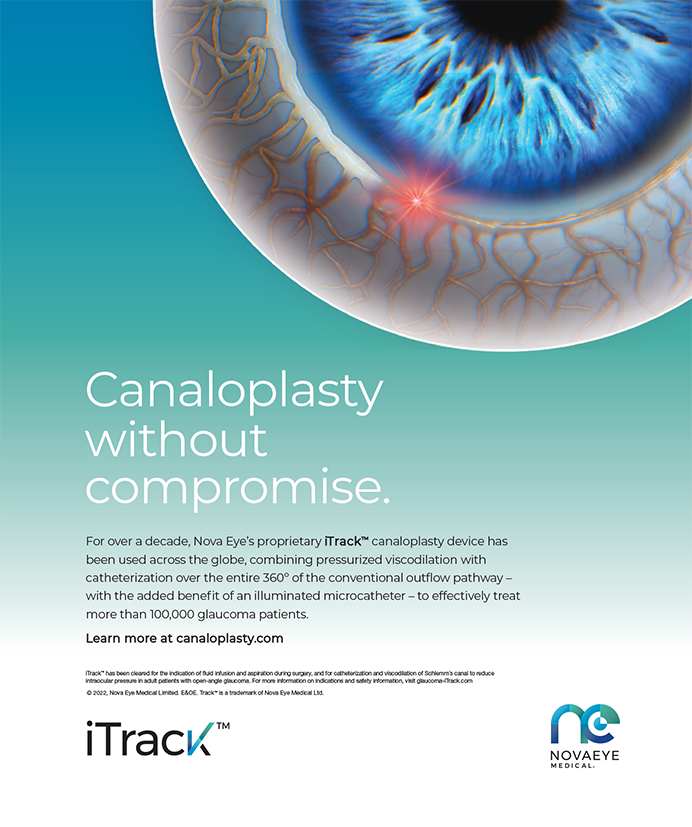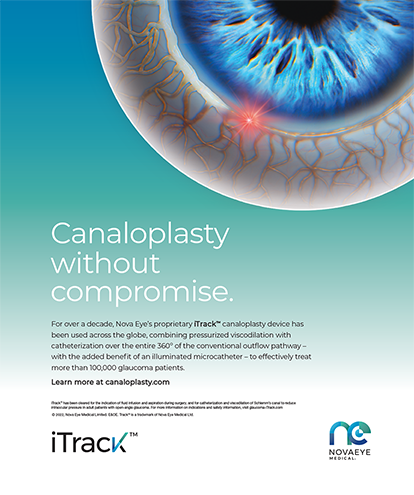
The number of patients with cataracts and glaucoma is about to explode. The surgical management of both conditions has undergone dramatic evolution and innovation in the past decade. Historically, the objective of cataract surgery was to remove a cloudy lens and restore patients’ preoperative vision and functioning with new glasses. Modern cataract surgery, in contrast, is often a refractive procedure that involves an out-of-pocket cost; patients expect the procedure to improve their quality of life by greatly reducing or eliminating their dependence on glasses. The new specialty of interventional glaucoma (IG) is similarly focused on improving patients’ quality of life in addition to preserving their vision (see What Is Interventional Glaucoma?).
What Is Interventional Glaucoma?
By Iqbal Ike K. Ahmed, MD, FRCSC, and H. George Tanaka, MD
Iqbal Ike K. Ahmed, MD, FRCSC
Philosopher Thomas Kuhn maintained that scientific research and thought are defined by paradigms. According to Kuhn, scientists typically accept an existing paradigm and then try to extend its scope over time. Eventually, however, their efforts may expose the paradigm’s inadequacies or contradict it entirely. An accumulation of these difficulties triggers a crisis, which, in turn, sparks an intellectual revolution or a paradigm shift. This is a model of change that we may be experiencing in glaucoma.
From issues with treatment noncompliance to the complex, chronic nature of the disease itself, glaucoma has long presented challenges to those who strive to manage it and those who live with it. These challenges have, in turn, served as an impetus for innovation and have contributed to the formation of a new school of thought: interventional glaucoma (IG).
The IG paradigm is founded on the objective to approach glaucoma in a proactive—not reactive—way and to intervene in a disease-centric and patient-centric manner. The IG specialist considers not only the disease’s impact on a patient’s quality of life but the treatment’s impact as well. Although MIGS was developed with this in mind, IG does not refer solely to one type of intervention.
Those who can view glaucoma from the patient’s perspective and factor quality of life into their treatment decision-making will be able to prioritize an IG mindset. As innovation continues and this patient-centric outlook grows, we can all approach glaucoma in a way that addresses safety, efficacy, and quality of life. The path is long, and there is much to accomplish; the desire, however, to truly improve the lives of our patients with glaucoma is the driving force we need to push this movement forward.
H. George Tanaka, MD
The IG mindset can include straightforward decision-making, such as offering selective laser trabeculoplasty over eye drops as an initial treatment for glaucoma (an option supported by the LIGHT study).
However, in a broader sense, IG can be considered a new specialty encompassing two areas: novel procedures designed to enhance aqueous outflow and novel drug delivery systems. These minimally invasive procedures allow aqueous humor to bypass the trabecular meshwork or direct aqueous humor into the suprachoroidal or subconjunctival space.
In contrast to traditional glaucoma surgeries such as trabeculectomy and tube shunt implantation, MIGS procedures are less invasive, carry less risk, offer quicker postoperative recovery, spare the conjunctiva, minimally affect refractive error, and require less postoperative management. In general, MIGS is less effective than traditional surgery in lowering IOP. However, along with new sustained-release drug delivery systems, MIGS may allow patients with mild to moderate glaucoma to reduce the number of glaucoma drops they take and may mitigate the drawbacks of medical IOP-lowering treatment, such as local and systemic side effects, cost, and the need for compliance with its associated psychological burden, thereby improving the patient’s quality of life.
IG has enabled earlier procedural intervention in the treatment of glaucoma patients, and the movement has caught on among glaucoma specialists and comprehensive ophthalmologists. The goal of glaucoma treatment has always been to prevent irreversible blindness, but IG has allowed us to shift our focus to a more patient-centered approach that seeks to improve patients’ quality of life by reducing the medication burden. In addition, cataract surgery is now a refractive procedure with the goal of reducing dependence on glasses and contact lenses as well as improving quality of vision. Combining cataract surgery with IG in patients with mild glaucoma allows an additional improvement in quality of life without affecting refractive outcomes.
Want to learn more about the interventional glaucoma mindset?
Check out the January/February 2020 issue of Glaucoma Today!
The intersection of refractive cataract surgery and IG presents challenges and opportunities for the comanagement of patients by cataract and glaucoma specialists.
TRABECULECTOMY VERSUS MIGS
For a long time, trabeculectomy was the only glaucoma procedure that could be combined with cataract surgery. Despite its drawbacks, trabeculectomy remains the gold standard for lowering IOP against which all other glaucoma procedures are judged. Trabeculectomy continues to be a critically relevant surgical option, particularly for patients with severely compromised optic nerves. The vast majority of glaucoma patients, however, have mild to moderate disease that is well controlled by one or two topical medications and do not require the subphysiologic IOPs achievable with trabeculectomy. The higher risk of traditional filtration surgery is not justified in these patients with stable disease.
Additionally, the refractive unpredictability of trabeculectomy caused by postoperative astigmatism or hypotony can make it impossible to obtain a desirable refractive result after cataract surgery. The prolonged visual recovery associated with trabeculectomy also diminishes the postoperative wow factor of refractive cataract surgery.
MIGS is the pillar of IG. Compared with traditional glaucoma surgery, MIGS procedures are safer and less invasive. They also involve a shorter recovery period and offer greater refractive predictability when combined with cataract surgery. The relative downside of MIGS is that these surgeries are generally less effective and predictable at lowering IOP than trabeculectomy. The expectation with MIGS is therefore a reduced medication burden—not an absolute lowering of IOP. This is an appropriate goal for patients who have mild, well-controlled glaucoma. Reducing the burden of medication improves the health of the ocular surface, the visual performance of standard and premium IOLs, and the patient’s overall quality of life.
CHOOSING A MIGS PROCEDURE
No two MIGS procedures are exactly alike, and head-to-head comparisons are few and far between. Nevertheless, a couple of generalizations can be made.
No. 1: The choice of procedure depends on the severity of the disease. Trabecular bypass procedures such as the iStent inject W (Glaukos) or Hydrus Microstent (Ivantis) and limited trabecular removal procedures such as goniotomy with a Kahook Dual Blade (New World Medical) are indicated for the treatment of mild glaucoma. More extensive trabecular opening procedures such as with the Omni Surgical System (Sight Sciences) and gonioscopy-assisted transluminal trabeculotomy with a suture or an iTrack (Nova Eye Medical) are indicated for the treatment of moderate glaucoma. Subconjunctival approaches (sometimes referred to as MIGS plus because they are slightly more invasive) such as a Xen Gel Stent (Allergan) or a Preserflo (Santen, not available in the United States) are indicated for the treatment of severe glaucoma.
No. 2: Phacoemulsification and MIGS procedures that bypass or remove the trabecular meshwork have complementary effects on IOP, whereas phacoemulsification and subconjunctival MIGS procedures have opposing effects on IOP. Removing the crystalline lens deepens the angle and likely promotes an expansion of a functional Schlemm canal, thereby enhancing the efficacy of a trabecular bypass device or trabecular removal at shunting aqueous into the collector system. In contrast, subconjunctival stents create a nonphysiologic outflow pathway that depends on an unobstructed potential space underneath the conjunctiva. Lens removal releases inflammatory cytokines that travel through the stent into the subconjunctival space and stimulate fibroblast proliferation. This leads to scar tissue formation around the stent, which impedes aqueous outflow and leads to an increase in IOP.
COMANAGEMENT OR REFERRAL?
The comanagement relationship between a cataract and glaucoma surgeon is dictated by the relative competency of the surgeons involved. Many comprehensive ophthalmologists are comfortable performing one or more MIGS procedures, and many glaucoma surgeons are likewise comfortable implanting both standard and premium IOLs. Some glaucoma specialists, however, have limited their practices to glaucoma surgery and do not perform cataract surgery, and some cataract surgeons do not perform any MIGS procedures whatsoever.
Cataract surgery alone often achieves a lasting and substantial IOP reduction in patients with primary angle-closure and mild primary angle-closure glaucoma because lens removal eliminates the phacomorphic and pupillary block components of angle closure in small hyperopic eyes.1 A more modest reduction of IOP is achievable with phacoemulsification alone in patients with primary open-angle glaucoma. If the patient is using one or no topical IOP-lowering drops, phacoemulsification alone may eliminate their need for glaucoma medication. A careful preoperative gonioscopic examination indicates the degree of IOP lowering that standalone cataract surgery is likely to achieve.
Patients with medically well-controlled mild to moderate glaucoma are ideal candidates for combined phaco/trabecular bypass MIGS. iStent inject W and Hydrus are reimbursed only in conjunction with cataract surgery, and not performing these MIGS procedures in patients with visually significant cataracts represents a lost opportunity for reducing their medication burden. These MIGS procedures are well within the skill set of cataract surgeons. Comprehensive ophthalmologists provide the majority of routine glaucoma care; thus, they should make an effort to incorporate these MIGS procedures into their surgical toolkit.
When treating patients who are using multiple IOP-lowering medications and/or who have more severe glaucoma, cataract surgeons who do not regularly perform MIGS should seek the expertise of a glaucoma surgeon who is experienced in performing these procedures. The cataract and glaucoma surgeons can perform their respective procedures in tag-team fashion on the same day if geography and schedules allow. Alternatively, a standalone MIGS procedure may be performed after cataract surgery to reduce the burden of medication, assuming IOP is well controlled. Patients with suboptimal IOP control who are using multiple medications may benefit from a more aggressive initial glaucoma procedure such as subconjunctival MIGS followed by cataract surgery.
CONCLUSION
Modern IOL technologies and MIGS procedures help cataract and glaucoma surgeons enhance patients’ quality of life by reducing their dependence on glasses and glaucoma medications. Glaucoma severity, the quality of IOP control, and the relative comfort zones of the cataract and glaucoma surgeons inform the necessity for, choice of, and timing of a MIGS procedure in relation to cataract surgery.
Cataract surgeons who limit their practice to refractive cataract surgery should foster a close working relationship with an IG specialist who is well-versed in MIGS. Conversely, glaucoma surgeons should make themselves available for consultation and as surgical backups for cases in which glaucoma and cataracts are present.
1. Azuara-Blanco A, Burr J, Ramsay C, et al; EAGLE Study Group. Effectiveness of early lens extraction for the treatment of primary angle-closure glaucoma (EAGLE): a randomised controlled trial. Lancet. 2016;388(10052):1389-1397.




